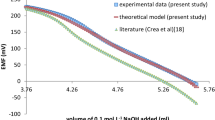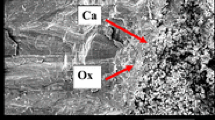Abstract
Calcium renal lithiasis formation depends on the balance between thermodynamic (supersaturation) and kinetic (inhibitors, nucleants)factors. In this paper, the importance of both groups was evaluated using(a) the complete urine analysis data obtained from 32 healthy volunteers and 141 active stone-formers, and (b) a comprehensive computer model to calculate the supersaturation values of calcium oxalate monohydrate,hydroxyapatite and brushite in each urine sample. The results of this evaluation were used to assess the possible effectiveness of a given pharmacological treatment.
Similar content being viewed by others
References
Balaji KC, Menon M. Mechanism of stone formation. Urol Clin North Am 1997; 24: 1–11.
Conte A, Pizá P, García-Raja A, Grases F, Costa-Bauzá A, Prieto RM. Test of urinary lithogen risk: usefulness in the evaluation of renal lithiasis treatment using crystallization inhibitors (citrate and phytate). Arch Esp Urol 1999; 3: 305–310.
Finlayson B. Physicochemical aspects of urolithiasis. Kidney Int 1978; 13: 344–360.
Fleisch H. Inhibitors and promoters of stone formation. Kidney Int 1978; 13: 361–371.
Grases F, Gracía-Ferragut L, Costa-Bauzá A, Conte A, García-Raja A. Simple test to evaluate the risk of urinary calcium stone formation. Clin Chim Acta 1997; 263: 45–55.
Grases F, Villacampa AI, Söhnel O, Königsberger E, May PM. Phosphate composition of precipitates from urine-like liquors. Cryst Res Technol 1997; 32: 707–715.
Königsberger E, Tran-Ho L-C. Solubility of substances related to urolithiasis – Experiments and computer modelling. Current Topics in Solution Chemistry 1997; 2: 183–202.
Mandel N. Mechanism of stone formation. Semin Nephrol 1996; 16: 364–374.
May PM, Murray K. JESS, a Joint Expert Speciation System – I. Raison d'ê tre. Talanta 1991; 38: 1409–1417.
May PM, Murray K. JESS, a Joint Expert Speciation System – II. The thermodynamic database. Talanta 1991; 38: 1419–1426.
May PM, Murray K. JESS, a Joint Expert Speciation System – III. Surrogate functions. Talanta 1993; 40: 819–825.
Rose MB. Renal stone formation. The inhibitory effect of urine on calcium oxalate precipitation. Invest Urol 1975; 12: 428–433.
Streit J, Tran-Ho L-C, Königsberger E. Solubility of the three calcium oxalate hydrates in sodium chloride solutions and urine-like liquor. Monatsh Chem, in press.
Author information
Authors and Affiliations
Rights and permissions
About this article
Cite this article
Grases, F., Costa-Bauzá, A., Königsberger, E. et al. Kinetic versus thermodynamic factors in calcium renal lithiasis. Int Urol Nephrol 32, 19–27 (2000). https://doi.org/10.1023/A:1007105328211
Issue Date:
DOI: https://doi.org/10.1023/A:1007105328211




